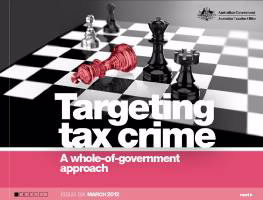The Australian Taxation Office has been asked to explain how it is possible for a BAS lodged by a representative of an incapacitated entity (receivers and managers) to be later amended by another entity without authorisation. In the actual case that gave rise to the question, a GST refund of approximately $650,000 was paid out to the receivers as a result of the unauthorised amendment. The case concerned sale of real property by the receivers.
The Tax Institute brought this matter to the ATO’s attention in March 2011 at a meeting of one of the ATO’s community consultation forums, the GST Sub-committee of the National Tax Liaison Group.
Minutes of the Meeting, recently published on the ATO website, are reproduced in full below. It appears that changes to ATO procedures may have already been made.
________________________________________________________
GST Minutes, March 2011
Agenda item 19 – Amendments of BAS lodged by representatives of an incapacitated entity. Issue 13.40 raised by the Tax Institute.
The Taxation Institute requests an explanation as to how it is possible for BAS lodged by a representative of an incapacitated entity (receivers and managers) to be later amended by another entity. Are there any checks in the BAS lodgment system for these unauthorised amendments to be stopped?
The facts relevant to this issue are that two individuals (partners in an accounting firm) were appointed as receivers and managers to sell certain new residential premises owned by a property developer that had defaulted on its repayments to a bank. The receivers had been appointed by the bank.
At the time of lodging the BAS as representatives of the incapacitated entity, the receivers were not satisfied on the basis of the information made available that they could pay GST under the margin scheme and instead paid GST under the basic rules, in respect of all sales of property. The sales proceeds were all paid to the bank.
After their appointment as receivers concluded, the property developer amended the BAS lodged by the receivers (through the business or tax agent portal). A refund of approximately $650,000 was processed without the ATO apparently doing any verification or other analysis (including as to section105-65 of Schedule 1 to the TAA). That refund was paid into the bank account of the receivers and managers (as this was still current with the ATO). This was the first time the receivers became aware that their BAS had been amended.
The matter now involves an ATO investigation of various issues, including the margin scheme valuation. The only issue for the purpose of this request is whether the ATO has any checks in its systems for such unauthorised amendments.
ATO response
Representatives of insolvent or incapacitated entities must be registered, as identified in section 58-20 of the GST Act. The ATO’s practice is to register representatives under a separate Client Account Centre (CAC), but under the same ABN as the incapacitated entity. This enables transactions attributable to the period of receivership/ administration to be recorded separately to those undertaken by the entity prior to and post the period of receivership/ administration.
Authorised contact persons, as nominated by the representatives, are listed against the separate role for the representative. Although the CAC appears on the account of the incapacitated entity, the representative is effectively treated as a separate entity. As a result, only the authorised person is allowed to lodge GST returns and amendments and make changes affecting the representative’s CAC.
Accordingly, a GST return lodged by a representative of an incapacitated entity should not be amended by a person associated with the incapacitated entity itself where that person is not authorised by the representative.
However, it is possible for someone, even where not authorised, to lodge a GST return or amendment. This could be done, for example, in paper form or through the business portal. Where someone has access to the portal in respect of the relevant ABN, that access is not restricted to specific CACs. It should be noted that the portal is a safe environment; it is password protected and encrypted, however this does not prevent unauthorised action being taken by those with access to the portal. If, for example, a person authorised by the company seeks to lodge an amendment in respect of a period the company was in receivership, the fact that the amendment request is not authorised may by identified by our systems and if so the amendment would not be processed. However, this will not occur in every case. Note that all transactions in the portal are logged; identifying the specific user taking the actions, and thus even if the amendment is processed, the fact the amendment request is unauthorised could later be identified.
The ATO take a risk based approach to reviewing lodgments, including amendments. This includes pre and post issue checks to identify fraudulent behaviour.
In light of the question that has been raised, we are considering whether further steps can be taken to reduce the risk of unauthorised amendments in these circumstances.
Meeting discussion
The ATO acknowledged that the situation as highlighted in the submission can occur on the portal. This issue has initiated action by the ATO to put in place steps to stop unauthorised amendments to BAS especially in these circumstances. The ATO considers this as a risk that requires further investigation and management to mitigate.
It was suggested by members that during the period that an entity was in insolvency, the ATO should incorporate steps to close off the incapacitated entity’s registration. The ATO is exploring ways for locking down those periods when administrators have been appointed or to trigger a review for amendments made to the BAS in those periods. The ATO is investigating the matter and how processes can be changed so that there is no reoccurrence.
The ATO also noted that access to the portal is logged, so unauthorised access in these cases can be identified. The ATO confirmed that if the representative entity has not made the relevant amendment (it has been made without authorisation by the formerly incapacitated entity), the representative entity would not be liable for a penalty if the amendment is a false or misleading statement.
| Action item |
2011.03.15
Amendments of BAS lodged by representatives of incapacitated entity |
| Description |
The ATO will provide an update out of session or at the next meeting on the progress made to have further controls in place so that BAS cannot be amended for periods in the past when an entity was incapacitated. |
| Responsibility |
ATO |
| Due date |
15 June 2011 |
 The case is Commissioner of Taxation v Kassem v Secatore [2012] FCAFC 124
The case is Commissioner of Taxation v Kassem v Secatore [2012] FCAFC 124
